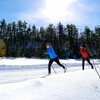
To Trail Or Not To Trail

The Algoma region is unique when it comes to snowmobiling in Northern Ontario, as it's one of the few places in the province that offers (and actively promotes) both on-trail and off-trail riding. Despite both options for riders, the majority of us Ontarians have been indoctrinated over time to believe the only kind of sledding one should participate in is on OFSC (Ontario Federation of Snowmobile Clubs) sanctioned trails.
While this might appeal to a large percentage of the population, a small but die-hard segment of enthusiasts crave the adventure of fresh powder and the “free-riding” that lies beyond staked boundaries of a groomed trail. With another winter riding season on the horizon, I thought it would be interesting to examine the pros and cons of these two vastly different types of riding, so you can be fully informed to give you the best riding experience next time you head out to the mighty Algoma region.

Pros Of Trail Riding

Riding on carefully maintained trails has its benefits. A consistent, packed snow base can be expected, and there’s virtually no chance of running into a buried tree stump or jagged rock hidden underneath the snow when on a marked trail. Despite having its critics, The OFSC and its local clubs and districts (in Algoma its District 13) do a wonderful job of routing and marking trails for the members to enjoy. Club volunteers put in a yeoman-like effort to ensure this, and it’s reflected in the large number of trail permits sold each year. Trails are strategically laid out with gas stations nearby for refuelling, restaurants and accommodations for those on long-haul or multi-day rides.
I’ve done countless trips with Ontario Tourism on the trails and each time I go, I’m amazed at how seamless the experience is. We’ll head out to ride for the day, and there always seems to be a tasty restaurant for lunch and a nearby hotel where we can access the trailhead, usually riding right out of the parking lot. This would explain why such a large segment of enthusiasts choose to stay on the trails. There’s also a good chance that if you suffer a breakdown, someone will be passing by who can offer assistance or a tow if need be.
Cons Of Trail Riding

The pros definitely outweigh the cons here, but there are a few things to consider. The structured approach to trail riding can be unappealing to some. With posted speed limits, a yearly permit to purchase, and the general sense of conforming to riding in specific areas (with everyone else), it could be argued, that following all these rules goes against one of the fundamental attractions to riding Powersports: freedom.
Pros Of Off-Trail Riding

Snowmobilers have been riding off-trail for years. I’d be willing to bet almost everyone reading this article has some memory from when they were growing up riding a sled in the farmer’s field near their parents’ house or banging through snowdrift-covered ditches to get to a friend’s place.

Back then we just called it riding, but thanks to a heavy influence from the mountain riders out west, backcountry sledding has made its way into our snowmobile culture and is now an accepted genre of snowmobiling—sort of. As I mentioned in the intro, Algoma is one of the few sledding destinations that has selected backcountry sledding opportunities. There are even outfits in the area that offer to guide you on a complete “long track” experience.

The biggest thing that separates the two types of riding is freedom. When you’re freeriding you literally create your own lines often in fresh “pow” (or powder). The feeling of riding through untouched snow is hard to describe but so rewarding. You almost feel like an explorer in another century, forging paths in pursuit of new lands.
Another big benefit you can’t get from trail riding is elevation. Sure there are hills out on the trail, but when freeriding the size and scope of hills are on another level. Sitting at the bottom of a massive slope knowing you’ve got to pin it if you want any chance of making it up gets my heart racing just thinking about it.
Another plus is that the degree of difficulty is totally up to you. When out freeriding, there are a multitude of ways to get around and in most cases, you don’t have to do anything “over your head” if you don’t want to. The last time I rode off-trail, there was a hill I didn’t feel comfortable tackling, and I simply found a longer but safer way to get around it. There are also wheelies, jumps, drop-ins, and all the other crazy stuff we’ve seen on YouTube that appeals to free-riders. Overall, the experience is simply summed up as freedom.
Cons Of Off-Trail Riding

The biggest downside to freeriding is conversely what makes it so appealing: unpredictability. As I stated earlier, you’ll almost never encounter a hidden rock or tree stump on the trail, waiting to smash the cowl or tunnel of your expensive new long track. But this is a constant reality when out in the unknown.
In addition to hidden obstacles, getting stuck in deep snow is also a genuine possibility. Sure, this can be viewed as a rite of passage for any true Boondocker, but that doesn’t mean it’s still not exhausting trying to muscle a machine weighing close to 600 lbs out of the snow’s powdery clutches.
Personally, my biggest gripe with off-trail riding was the difficulty. I realize this will be subjective depending on your skill level, but on the last trip I made out to do proper backcountry sledding in Algoma, there were several occasions I had to get off my machine and “hoof it” while the guide negotiated my steed down a steep hill or gnarly snowbank, where I didn’t feel comfortable.

I’ve illustrated fair points for both on- and off-trail riding, but ultimately you need to stick with what you’re most comfortable with and what best suits your needs. Either way, you’re going to be riding a snowmobile in some of the most beautiful terrains in the country, and that alone is a win-win situation!

Disclaimer
"Always ride within your limits, file a travel plan with a buddy, and never, and we mean, never, ride outside the stakes of an OFSC-sanctioned trail."
Recommended Articles

The Group of Seven in Algoma

9 Facts to Know about the Agawa Canyon Tour Train































